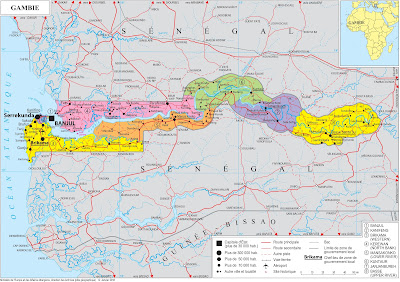The Gambia, often called “The Smiling Coast of Africa,” is the smallest country on mainland Africa, known for its warm hospitality, diverse wildlife, and rich cultural heritage along the life-giving Gambia River. Despite its small size, The Gambia offers beaches, vibrant markets, and authentic West African experiences.
Discover The Gambia
📍 Location: A narrow strip of land surrounded by Senegal, with the Atlantic Ocean on its western coast.
🏝️ River Life: The Gambia River runs through the entire country, shaping its landscape, agriculture, and cultural rhythms.
🌿 Birdwatcher’s Paradise: With over 560 bird species, The Gambia is a top destination for birdwatchers worldwide.
🌞 Warm Climate and Smiles: Sunny weather and the welcoming nature of Gambians make every visit feel like home.
Top Places to Visit in The Gambia
🏖️ Kololi and Kotu Beaches: Enjoy golden sand beaches, Atlantic waves, and vibrant beach bars perfect for sunsets.
🌿 Abuko Nature Reserve: A small but rich wildlife reserve where you can spot monkeys, antelopes, crocodiles, and diverse birdlife.
🏛️ Banjul: The small, relaxed capital city, home to the Albert Market, Arch 22, and views of the river mouth.
🦜 Makasutu Culture Forest: A beautiful eco-tourism site offering river canoe trips, forest walks, and cultural encounters.
🏝️ Kunta Kinteh Island (James Island): A UNESCO World Heritage site, reflecting The Gambia’s role in the transatlantic slave trade, offering a somber but important historical perspective.
Culture and Traditions
✨ Ethnic Diversity: The Gambia is home to Mandinka, Fula, Wolof, Jola, and other groups, each adding to its cultural richness.
✨ Music and Dance: Drumming and kora music (a West African harp-lute) are central to Gambian life.
✨ Markets: Colorful markets like Serekunda Market are perfect for exploring local crafts, textiles, and everyday life.
Gambian Cuisine
🍛 Domoda: A delicious peanut stew with meat or fish, served with rice.
🍚 Benachin (One Pot): A flavorful rice dish cooked with fish or meat and vegetables.
🍲 Yassa: Chicken or fish marinated with onions, lemon, and mustard, served with rice.
🍌 Fried Plantains: A popular snack or side dish.
🥤 Baobab Juice and Wonjo: Refreshing drinks made from local fruits and hibiscus.
Why Visit The Gambia?
✅ Friendly and Safe: Gambians are renowned for their hospitality, earning the country its nickname.
✅ Affordable Travel: Budget-friendly for travelers seeking authentic African experiences.
✅ Beaches and Wildlife: Relax on Atlantic beaches or explore nature reserves.
✅ Rich History: Learn about West Africa’s history through sites like Kunta Kinteh Island.
✅ Birdwatching and Nature: The Gambia is a paradise for nature lovers and photographers.
Practical Travel Tips
🛂 Visa: Many nationalities can enter visa-free or with a visa on arrival; confirm before travel.
🌤️ Best Time to Visit: November to May during the dry season for ideal weather.
🗣️ Language: English is the official language; Mandinka, Wolof, and Fula are widely spoken.
👗 Dress Light and Modest: Light, breathable clothing is ideal; modest attire is appreciated in rural areas.
Final Thoughts 🌍✨
The Gambia may be small, but it offers big smiles, colorful culture, sun-drenched beaches, and river adventures. Whether you wish to relax by the ocean, listen to the kora under the stars, or explore mangroves and markets, The Gambia welcomes you warmly to its smiling coast.
✈️ Interested in Africa’s 54 unique countries?
Explore them all on our Africa Main Page.
🏠 For more travel, art, and cultural explorations, visit our CRA ARTS Main Page.
Have you heard of The Gambia’s welcoming hospitality or dreamt of exploring its riverside culture? Share your thoughts or questions below!






Comments
Post a Comment